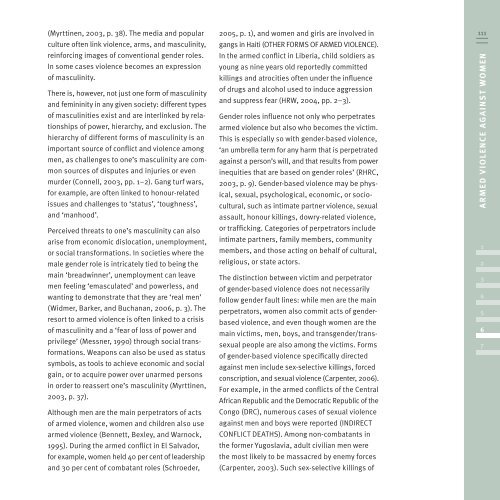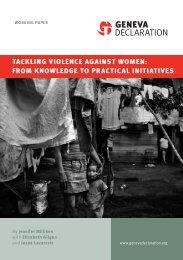Global Burden of Armed Violence - The Geneva Declaration on ...
Global Burden of Armed Violence - The Geneva Declaration on ...
Global Burden of Armed Violence - The Geneva Declaration on ...
Create successful ePaper yourself
Turn your PDF publications into a flip-book with our unique Google optimized e-Paper software.
(Myrttinen, 2003, p. 38). <str<strong>on</strong>g>The</str<strong>on</strong>g> media and popular<br />
culture <str<strong>on</strong>g>of</str<strong>on</strong>g>ten link violence, arms, and masculinity,<br />
reinforcing images <str<strong>on</strong>g>of</str<strong>on</strong>g> c<strong>on</strong>venti<strong>on</strong>al gender roles.<br />
In some cases violence becomes an expressi<strong>on</strong><br />
<str<strong>on</strong>g>of</str<strong>on</strong>g> masculinity.<br />
<str<strong>on</strong>g>The</str<strong>on</strong>g>re is, however, not just <strong>on</strong>e form <str<strong>on</strong>g>of</str<strong>on</strong>g> masculinity<br />
and femininity in any given society: different types<br />
<str<strong>on</strong>g>of</str<strong>on</strong>g> masculinities exist and are interlinked by rela-<br />
ti<strong>on</strong>ships <str<strong>on</strong>g>of</str<strong>on</strong>g> power, hierarchy, and exclusi<strong>on</strong>. <str<strong>on</strong>g>The</str<strong>on</strong>g><br />
hierarchy <str<strong>on</strong>g>of</str<strong>on</strong>g> different forms <str<strong>on</strong>g>of</str<strong>on</strong>g> masculinity is an<br />
important source <str<strong>on</strong>g>of</str<strong>on</strong>g> c<strong>on</strong>flict and violence am<strong>on</strong>g<br />
men, as challenges to <strong>on</strong>e’s masculinity are com-<br />
m<strong>on</strong> sources <str<strong>on</strong>g>of</str<strong>on</strong>g> disputes and injuries or even<br />
murder (C<strong>on</strong>nell, 2003, pp. 1–2). Gang turf wars,<br />
for example, are <str<strong>on</strong>g>of</str<strong>on</strong>g>ten linked to h<strong>on</strong>our-related<br />
issues and challenges to ‘status’, ‘toughness’,<br />
and ‘manhood’.<br />
Perceived threats to <strong>on</strong>e’s masculinity can also<br />
arise from ec<strong>on</strong>omic dislocati<strong>on</strong>, unemployment,<br />
or social transformati<strong>on</strong>s. In societies where the<br />
male gender role is intricately tied to being the<br />
main ‘breadwinner’, unemployment can leave<br />
men feeling ‘emasculated’ and powerless, and<br />
wanting to dem<strong>on</strong>strate that they are ‘real men’<br />
(Widmer, Barker, and Buchanan, 2006, p. 3). <str<strong>on</strong>g>The</str<strong>on</strong>g><br />
resort to armed violence is <str<strong>on</strong>g>of</str<strong>on</strong>g>ten linked to a crisis<br />
<str<strong>on</strong>g>of</str<strong>on</strong>g> masculinity and a ‘fear <str<strong>on</strong>g>of</str<strong>on</strong>g> loss <str<strong>on</strong>g>of</str<strong>on</strong>g> power and<br />
privilege’ (Messner, 1990) through social trans-<br />
formati<strong>on</strong>s. Weap<strong>on</strong>s can also be used as status<br />
symbols, as tools to achieve ec<strong>on</strong>omic and social<br />
gain, or to acquire power over unarmed pers<strong>on</strong>s<br />
in order to reassert <strong>on</strong>e’s masculinity (Myrttinen,<br />
2003, p. 37).<br />
Although men are the main perpetrators <str<strong>on</strong>g>of</str<strong>on</strong>g> acts<br />
<str<strong>on</strong>g>of</str<strong>on</strong>g> armed violence, women and children also use<br />
armed violence (Bennett, Bexley, and Warnock,<br />
1995). During the armed c<strong>on</strong>flict in El Salvador,<br />
for example, women held 40 per cent <str<strong>on</strong>g>of</str<strong>on</strong>g> leadership<br />
and 30 per cent <str<strong>on</strong>g>of</str<strong>on</strong>g> combatant roles (Schroeder,<br />
2005, p. 1), and women and girls are involved in<br />
gangs in Haiti (OTHER FORMS OF ARMED VIOLENCE).<br />
In the armed c<strong>on</strong>flict in Liberia, child soldiers as<br />
young as nine years old reportedly committed<br />
killings and atrocities <str<strong>on</strong>g>of</str<strong>on</strong>g>ten under the influence<br />
<str<strong>on</strong>g>of</str<strong>on</strong>g> drugs and alcohol used to induce aggressi<strong>on</strong><br />
and suppress fear (HRW, 2004, pp. 2–3).<br />
Gender roles influence not <strong>on</strong>ly who perpetrates<br />
armed violence but also who becomes the victim.<br />
This is especially so with gender-based violence,<br />
‘an umbrella term for any harm that is perpetrated<br />
against a pers<strong>on</strong>’s will, and that results from power<br />
inequities that are based <strong>on</strong> gender roles’ (RHRC,<br />
2003, p. 9). Gender-based violence may be phys-<br />
ical, sexual, psychological, ec<strong>on</strong>omic, or socio-<br />
cultural, such as intimate partner violence, sexual<br />
assault, h<strong>on</strong>our killings, dowry-related violence,<br />
or trafficking. Categories <str<strong>on</strong>g>of</str<strong>on</strong>g> perpetrators include<br />
intimate partners, family members, community<br />
members, and those acting <strong>on</strong> behalf <str<strong>on</strong>g>of</str<strong>on</strong>g> cultural,<br />
religious, or state actors.<br />
<str<strong>on</strong>g>The</str<strong>on</strong>g> distincti<strong>on</strong> between victim and perpetrator<br />
<str<strong>on</strong>g>of</str<strong>on</strong>g> gender-based violence does not necessarily<br />
follow gender fault lines: while men are the main<br />
perpetrators, women also commit acts <str<strong>on</strong>g>of</str<strong>on</strong>g> gender-<br />
based violence, and even though women are the<br />
main victims, men, boys, and transgender/trans-<br />
sexual people are also am<strong>on</strong>g the victims. Forms<br />
<str<strong>on</strong>g>of</str<strong>on</strong>g> gender-based violence specifically directed<br />
against men include sex-selective killings, forced<br />
c<strong>on</strong>scripti<strong>on</strong>, and sexual violence (Carpenter, 2006).<br />
For example, in the armed c<strong>on</strong>flicts <str<strong>on</strong>g>of</str<strong>on</strong>g> the Central<br />
African Republic and the Democratic Republic <str<strong>on</strong>g>of</str<strong>on</strong>g> the<br />
C<strong>on</strong>go (DRC), numerous cases <str<strong>on</strong>g>of</str<strong>on</strong>g> sexual violence<br />
against men and boys were reported (INDIRECT<br />
CONFLICT DEATHS). Am<strong>on</strong>g n<strong>on</strong>-combatants in<br />
the former Yugoslavia, adult civilian men were<br />
the most likely to be massacred by enemy forces<br />
(Carpenter, 2003). Such sex-selective killings <str<strong>on</strong>g>of</str<strong>on</strong>g><br />
111<br />
A R M E D V I O L E N C E AG A I N S T WOMEN<br />
1<br />
2<br />
3<br />
4<br />
5<br />
6<br />
7









